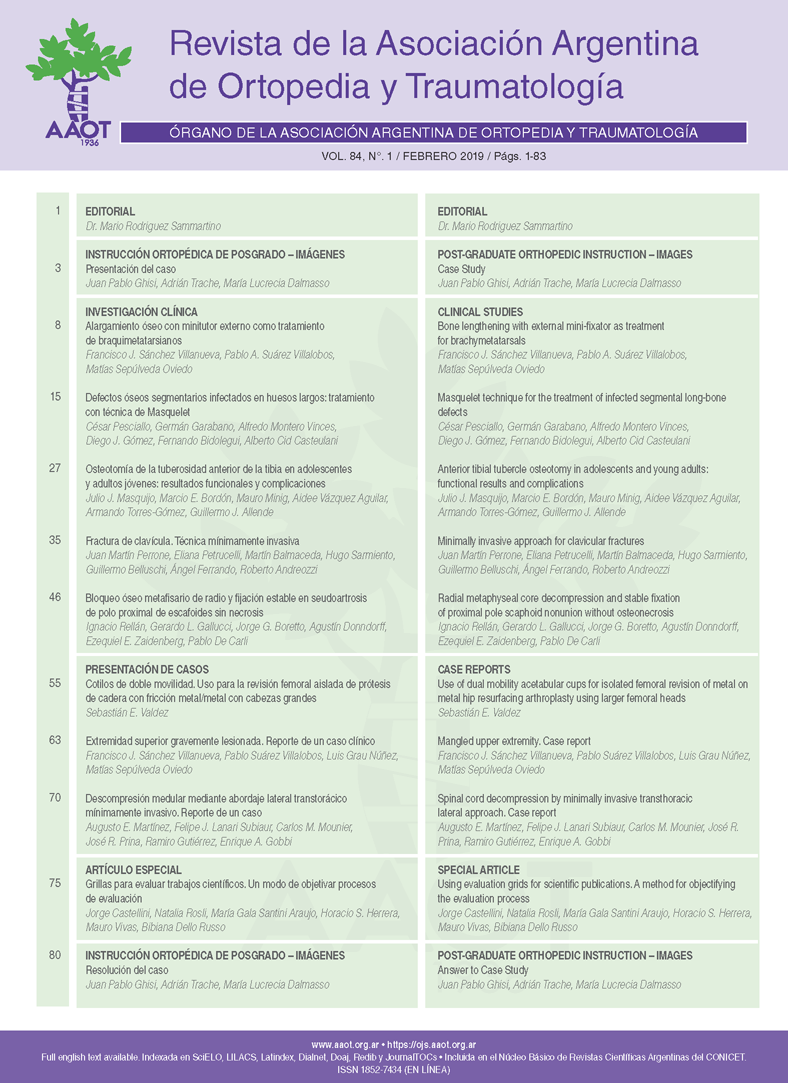Spinal cord decompression by minimally invasive transthoracic lateral approach. Case report
Main Article Content
Abstract
We present the case of a 64-year-old male with spinal compression symptoms, central disc herniation calcified at the fifth thoracic vertebra, which migrated to the lower end of the sixth thoracic vertebra. Diagnosis was clear for spinal cord compression. Partial posterior corpectomy of the sixth vertebra was performed with a minimally invasive transthoracic transpleural lateral approach and without additional fixation. The patient had a good outcome on follow-up, without progression of neurological symptoms or residual rib pain.
Minimally invasive lateral approaches are valid techniques for the treatment of compression disorders of the thoracic spine, with low rates of morbidity and mortality, and a rapid recovery.
Downloads
Metrics
Article Details

This work is licensed under a Creative Commons Attribution-NonCommercial-ShareAlike 4.0 International License.
Manuscript acceptance by the Journal implies the simultaneous non-submission to any other journal or publishing house. The RAAOT is under the Licencia Creative Commnos Atribución-NoComercial-Compartir Obras Derivadas Igual 4.0 Internacional (CC-BY-NC.SA 4.0) (http://creativecommons.org/licences/by-nc-sa/4.0/deed.es). Articles can be shared, copied, distributed, modified, altered, transformed into a derivative work, executed and publicly communicated, provided a) the authors and the original publication (Journal, Publisher and URL) are mentioned, b) they are not used for commercial purposes, c) the same terms of the license are maintained.
In the event that the manuscript is approved for its next publication, the authors retain the copyright and will assign to the journal the rights of publication, edition, reproduction, distribution, exhibition and communication at a national and international level in the different databases. data, repositories and portals.
It is hereby stated that the mentioned manuscript has not been published and that it is not being printed in any other national or foreign journal.
The authors hereby accept the necessary modifications, suggested by the reviewers, in order to adapt the manuscript to the style and publication rules of this Journal.
References
2. Arseni C, Nash F. Thoracic intervertebral disc protrusion: a clinical study. J Neurosurg 1960;17:418-30.
DOI: 10.3171/jns.1960.17.3.0418
3. Hulme A. The surgical approach to thoracic intervertebral disc protrusions. J Neurosurg Psychiatry 1960;23:133-7. Doi: 10.1136/jnnp.23.2.133
4. Le roux PD, Haglund MM, Harris AB. Thoracic disc disease: experience with the transpedicular approach in twenty
consecutive patients. Neurosurgery 1993;33:58-66. DOI:10.1097/00006123-199307000-00009
5. Perot Jr PL, Munro DD. Transthoracic removal of midline thoracic disc protrusions causing spinal cord compression. J Neurosurg 1969;31:452-8. DOI:10.3171/jns.1969.31.4.0452
6. Rosenthal D, Rosenthal R, de Simone A. Removal of a protruded thoracic disc using microsurgical endoscopy. A new technique. Spine 1994;19(9):1087-91. DOI: 10.1097/00007632-199405000-00018
7. Dakwar E, Ahmadian A, Uribe JS. The anatomical relationship of the diaphragm to the thoracolumbar junction during the minimally invasive lateral extracelomic (retropleural/retroperitoneal) approach. J Neurosurg Spine 2012;16:359-64.
DOI: 10.3171/2011.12.SPINE11626
8. Uribe JS, Smith WD, Pimenta L, Hartl R, Dakwar E, Modhia UM. Minimally invasive lateral approach for symptomatic thoracic disc herniation: initial multi-center clinical experience. J Neurosurg Spine 2012;16:264-79. DOI: 10.3171/2011.10.SPINE11291
9. Karmakar MK, Ho AM. Postthoracotomy pain syndrome. Thora Surg Clin 2004;14:345-52. DOI:10.1016/S1547-4127(04)00022-2
10. Hann PP, Kenny K, Dickman CA. Thoracoscopic approaches to the thoracic spine: experience with 241 surgical procedures. Neurosurgery 2002;52(Suppl 5):88-95. DOI:10.1097/00006123-200211002-00013
11. McAfee PC, Regan JR, Zdeblick T, Zuckerman J, Picetti GD 3rd, Heim S, et al. The incidence of complications in endoscopic anterior thoracolumbar spinal reconstructive surgery. A prospective multicenter study comprising the first 100 consecutive cases. Spine (Phila PA 1976) 1995;20:1624-32. DOI:10.1097/00007632-199507150-00012
12. Deviren V, Kuelling FA, Poulter G, Pekmezci M. Minimal invasive anterolateral transthoracic transpleural approach: a novel technique for thoracic disc herniation. A review of the literature, description of a new surgical technique and experience with first 12 consecutive patients. J Spinal Disord Tech 2011;24:E40-8.
DOI: 10.1097/BSD.0b013e318220af6f
13. Nacar OA, Ulu MO, Pekmezci M, Deviren V. Surgical treatment of thoracic disc disease via minimally invasive lateral transthoracic trans/retropleural approach: analysis of 33 patients. Neurosurg Rev 2013;36:455-65. DOI: 10.1007/s10143-013-0461-2
14. Uribe JS, Dakwar E, Le TV, Christian G, Serrano S, Smith WD. Minimally invasive surgery treatment for thoracic spine tumor removal: a mini-open, lateral approach. Spine 2010;35:S347-54. DOI: 10.1097/BRS.0b013e3182022d0f
15. White AA III, Panjabi MM. Clinical biomechanics of the spine, 2nd ed. Philadelphia: Lippincott, Williams & Wilkins; 1990. ISBN-10: 0397507208

